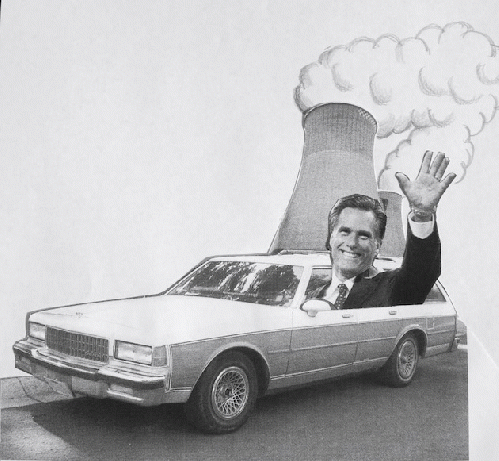
It's full (radioactive) steam ahead for non-renewable Mitt.
(Image by Cartoon collage by Gar Smith) Details DMCA
It's full (radioactive) steam ahead for non-renewable Mitt. by Cartoon collage by Gar Smith
By Gar Smith
In his campaign speeches, GOP presidential candidate Mitt Romney has made it carbon-clear: if you live on his planet, you're going to be consuming "good, old-fashioned American power"--the kind produced by coal, oil and uranium. "You can't drive a car with a windmill on it," Romney scoffs.
Well, sure: a windmill bolted atop a car is a zany image. But what would a car look like if it were powered by one of Mitt's preferred fuels?
An oil-powered car would have a metal derrick rising from its rooftop and it would be pinned to the ground by a mile of drilling infrastructure. Adding to the inconvenience, it would most likely be parked some distance from your front porch. Say, in Saudi Arabia.
If Mitt's ride were a coal-powered sedan, it would be a real clunker. In the US, the "latest model" would be 20 years old, there would only be 600 on the road and it would take 2.2 billion gallons of water and 2,333 tons of coal to run one for a year. The tailpipe would puff arsenic, sulfur, radioisotopes, soot, and greenhouse gases. Acid rain from your exhaust would probably kill your neighbor's begonias.
If a car were built like a nuclear reactor, you probably wouldn't want to buy one. (You'd have to wait at least eight years between ordering and final delivery, the original purchase price would double and, without billion-dollar government loans, it might never get built.)
A nuclear reactor is like a high-performance sports car built to go 600 miles per hour in a world where the speed limit is 60. To run it safely, you'd need to keep one foot on the brake pedal--all the time. (And "game over" if the brakes fail.)
If a reactor were like a car, the radiator would no longer fit under the hood. With 33% thermal efficiency, your car would spew clouds of superheated steam visible from 20 blocks away. Every 17 months or so, you'd need to stop and replace the engine. Instead of a gas station, you'd need to visit a specialized garage where a team of highly paid mechanics would spend two months completing the refueling process.
If a car was nuclear-powered, you could never walk off and leave the engine running. With a regular car, the engine eventually runs out of gas and stops. With an unattended reactor, the engine eventually runs out of control and explodes.
And when it reaches its mandatory retirement age, there won't be any junkyards for your car. You'd need to encase the radioactive hulk in concrete and store it in your backyard--for 25,000 years.
On the other hand, imagine if a reactor was treated like a car: If three Ford Explorers parked side-by-side on the coast of Japan suddenly exploded--one after another--the government would surely order a recall.
All things considered, I'd rather take my chances on a car with a wind turbine on the roof.
Gar Smith is editor emeritus of Earth Island Journal and author of Nuclear Roulette: The Truth about the Most Dangerous Energy Source on Earth (Chelsea Green).




